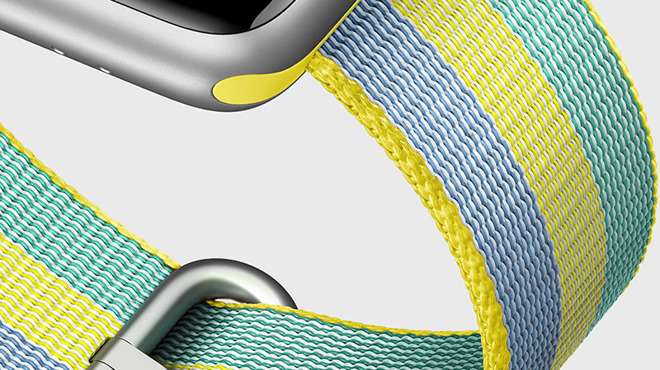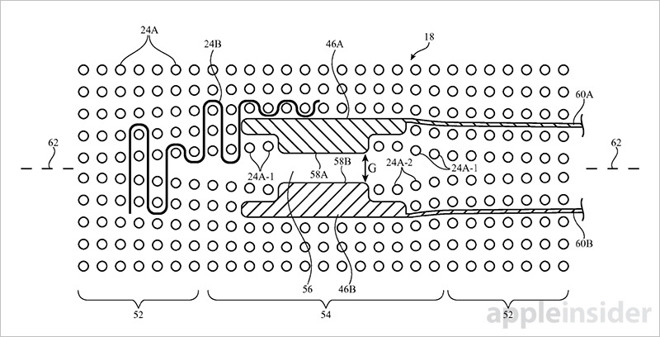Apple is actively investigating methods of embedding electronic components into woven fabric materials, technology that might be applied to Apple Watch strap designs to offload user interfaces into physical space and expand device functionality.

As noted in a trio of Apple patent applications published on Thursday, the company is continuing exploration into advanced fabric manufacturing technology. Specifically, the documents published today detail methods by which electrical components like buttons, switches and other functional equipment.
As published by the U.S. Patent and Trademark Office, Apple's patent application for "Three-Dimensional Fabric With Embedded Input-Output Devices" explores the possibility of utilizing three-dimensional braiding apparatus to create fabric structures with pockets into which electrical parts are disposed. More accurately, these components are installed into small pockets formed into the fabric material during production.

Source: USPTO
The invention supports a variety of hardware solutions, including switches, buttons, touch pads, microphones, speakers, vibrators, cameras, status indicators and a bevy of sensors.
Apple details a button or switch solution that incorporates layers of fabric and permanent magnets. In one embodiment, two magnets are covered in metal and aligned opposite each other in a fabric pocket. Conductive leads are woven into the fabric and connect the switch to a control module.
To keep the switch open, the magnets are aligned to repel each other and are placed in a biasing structure formed from springs or foam. Only when the two conductive components are brought together by manual force is the switch circuit closed.
Apple specifies the woven fabric component tech can be applied to a removable device case.
A separate filing for "Fabric With Embedded Electrical Components" details a method of integrating a variety of components directly into woven materials. Using a customized weaving process and specially designed packages, the invention provides a technique by which parts are locked between weft and warp fibers.
In some embodiments, a component package containing sensors, LEDs, transducers or other microelectromechanical device is encapsulated in a housing that incorporates fiber guiding structures. For example, grooves or guide posts can be employed to prevent woven fibers from slipping off the package.
Electrical contacts disposed within the grooves, or elsewhere on the package body, act as terminals and interface with conductive fibers interlaced throughout the woven material substrate.
Perhaps more interesting is Apple's third fabric-centric invention that describes a "Fabric sensing device." Combining theories illustrated in the two applications above, this third property details a touch-sensitive textile device capable of detecting changes in capacitive coupling within the woven material.
In other words, the fabric senses user touch and, in some configurations, force.
In some embodiments, the fabric may incorporate a capacitive touch sensor configured to detect a user's finger near or at the surface of the textile. Such implementations call for at least two sets of conductive thread to be oriented transverse of each other in the larger material body. This same orientation can be used in resistive sensor stacks that detect touch by monitoring changes in impedance.
As for force sensing, the IP describes a two-layer touch sensor separated by a non-conductive spacer like monofilament yarn. When a force is applied to one side of the fabric, the conductive layers are pushed together, resulting in a change in capacitance that can be evaluated by a connected sensing circuit.
Apple notes the fabric sensing device can be deployed as part of a traditional garment, such as the sleeve of a jacket, but might also be woven into a bracelet or arm band.
Whether Apple intends to build its embedded fabric patents into a shipping product is unclear, but the company is expected to announce a next-generation Apple Watch device at an event next month. Not much is known about the so-called "Series 3" wearable, though rumors claim LTE connectivity will be the hardware's headline feature.
More recent reports say the device will retain the same form factor Apple debuted with the original Watch in 2015, meaning the wearable will likely include a diagnostics port under its strap connector. The interface could potentially give rise to a number of accessories, including aftermarket straps based on today's patent applications, as it supports both power and real-time data transfer.
Each of the three patents were filed for in March 2017. The three-dimensional fabric with embedded input-output devices application credits Daniel A. Podhajny and James G. Griffin, II as its inventors, while the fabric with electrical components IP names Daniel D. Sunshine, Daniel A. Podhajny, Kathryn P. Crews and Yohji Hamada as authors. The fabric sensing device document cites Daniel A. Podhajny and James G. Griffin, II as inventors.